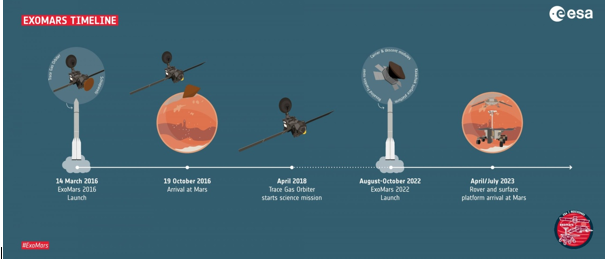

The European Space Agency (ESA) announced that its ExoMars Rosalind Franklin rover mission would not fly this year due to technical issues and the logistical impact.
Context
The European Space Agency (ESA) announced that its ExoMars Rosalind Franklin rover mission would not fly this year due to technical issues and the logistical impact.
About
- The ExoMars rover is Europe’s first Mars rover. Named after Rosalind Franklin, a British pioneer of DNA science, the robotic explorer will search for signs of life on the red planet’s surface.
- The ExoMars rover is a follow-on to ESA’s ExoMars Orbiter mission, which reached the red planet in 2016.
- That mission consisted of two parts:
- the Trace Gas Orbiter (TGO)
- The orbiter is performing science work and will serve as a communications relay for the second phase of the program — a rover and landing surface platform.
- the Schiaparelli lander, a technology demonstrator
- Unfortunately, the Schiaparelli crash-landed during its descent to the Martian surface.
- the Trace Gas Orbiter (TGO)
- The Rosalind Franklin rover is a second ExoMars mission to search for signs of life at depths up to two meters below the martian surface.
- It consists of a Russian-led surface platform and the European-led rover, to be launched on a Russian Proton rocket from Baikonur.
The delay:
- The launch of the second ExoMars mission, a collaboration with the Russian Space Agency (Roscosmos), was initially planned for July or August of this year.
- However, the launch has been postponed to 2022 due to technical issues and the logistical impact due to the global Conoavirus outbreak.
- The agency needs more time to troubleshoot issues with the spacecraft’s parachute system as well as precise electronics, so the delay is necessary.
- Also, the recent coronavirus outbreak that’s spreading around the globe isn’t helping.
- So instead of rushing, the team is taking the next two years to conduct extensive testing and make sure they get it right.
Why landing on Mars is challenging?
- Landing a spacecraft on Mars is hard. There are a bunch of challenges with Mars, including its lack of a protective magnetosphere and lower surface gravity.
- But one of the biggest is its thin atmosphere of carbon dioxide.
- The planet’s atmosphere is thinner than what we see on Earth, and as such its takes a combination of sophisticated tools, including heat shields, retrorockets, and even giant, inflatable airbags, to safely touch down on the surface.
- Historically, missions to Mars are launched from Earth during the flight windows that open up every two year or so when Earth and Mars are close together.
- ExoMars flew in 2016, InSight in 2018 and the Mars 2020 rover will fly in 2020.
- The missions follow interplanetary transfer trajectory designed to either get there the fastest, or with the least amount of fuel.
The ExoMars rover mission was initially scheduled to launch in 2018, but was delayed to 2020 due to delays in European and Russian industrial activities.When the Rosalind Franklin rover arrives at Mars it will join the ExoMars Trace Gas Orbiter, which has been in orbit around the Red Planet since October 2016. TGO will act as a relay station for the mission while continuing its own science mission.



